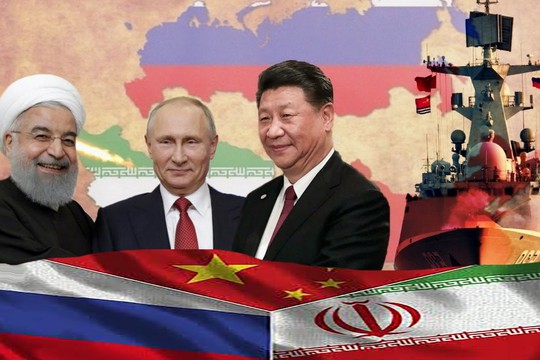Assessing the economic threat posed by the anti-Western axis, cries ‘The Economist’. Vladimir Putin, Russia’s president, and Ebrahim Raisi, his Iranian counterpart, have several things in common. Both belong to a tiny group of leaders personally targeted by American sanctions. And both seem increasingly fond of one another. In December they met in the Kremlin to discuss the war in Gaza. On March 18th Mr Raisi was quick to congratulate Mr Putin on his “decisive” election victory.
For much of history, Russia, Iran and China were less chummy. Lately, however, America has changed the dynamic. In 2020, two years after exiting a deal limiting Iran’s nuclear programme, it reimposed a trade embargo on the country; more penalties were announced in January, to punish Iran for backing Hamas and Houthi rebels. Russia fell under Western sanctions in 2022, after invading Ukraine, which were recently tightened. Meanwhile, China faces restrictions of its own, which could become much more stringent if Donald Trump is elected president in November. United by a common foe, the trio now vow to advance a common foreign policy: support for a multipolar world no longer dominated by America. All see stronger economic ties as the basis for their alliance.
China has promised a “no limits” partnership with Russia, and signed a 25-year “strategic agreement” with Iran in 2021. All three countries are members of the same multilateral clubs, such as the BRICS. Bilateral trade is growing; plans are being drawn up for tariff-free blocs, new payment systems and trade routes that bypass Western-controlled places. For America and its allies, this is the stuff of nightmares. A thriving anti-Western axis could dodge sanctions, win wars and recruit other actors. The entente involves areas where links are already strong, others where collaboration is only partial and some unresolved questions. What might the alliance look like in five to ten years?
Start with booming business. China has long been a big customer of petrostates, including Iran and Russia. But these two also used to sell lots of oil to Europe, which was close to Russia’s fields and easy to reach from the Gulf. Since Europe started snubbing them, China has been buying barrels at bargain prices. Inflows from Russia’s western ports have risen to 500,000 barrels a day (b/d), from less than 100,000 pre-war, reckons Reid l’Anson of Kpler, a data firm.
Whereas Western sanctions allow anyone outside the g7 to still import Russian oil, the Iranian energy industry is subject to so-called secondary sanctions, which restrict third countries. Since 2022, however, the Biden administration has relaxed enforcement and is willing to see rules broken if it means lower prices. The result has been a surge in Chinese imports, with the beneficiaries not China’s state-owned firms, which could one day be exposed to sanctions, but smaller “teapot refineries” with no presence abroad. China also gets cheap gas from Russia: imports via the Power of Siberia pipeline have doubled
China’s exports to Russia have duly soared. Instead of shoes and t-shirts, it tried to sell high-value wares, such as machinery and mechanical devices, for which Russia acted as a test market. Last year the biggest importer of Chinese automobiles was not Europe, a destination for its electric vehicles, but Russia, which purchased three times as many petrol cars it did as before the war.
The alliance has already achieved something remarkable: saving its junior members from collapse in the face of Western embargoes. But has it reached its full potential? The answer depends on the ability of its members to surmount external and internal obstacles.
Various forums aim to promote co-operation and cross-border investment. Last July Iran became the ninth member of the Shanghai Co-operation Organisation, a China-led security alliance that also includes Russia. In December it signed a free-trade agreement with the Russia-led Eurasian Economic Union, which covers much of Central Asia. In January it joined the brics, an emerging-market group that includes both China and Russia.
These get-togethers give the trio more chances to talk. At recent summits, Iranian and Russian ministers have revived negotiations to extend the International North-South Transport Corridor (instc), a 7,200km route connecting Russia to the Indian Ocean via Iran. At present Russian grain must travel to the Middle East through the nato-controlled Bosporus. The proposal, which includes a mixture of roads, rail and ports, could turn Iran into an export outlet for Russia.
The West has little appetite for wholesale secondary sanctions. But existing measures will cause trouble. In December America announced penalties for anyone dealing with Russian firms in industries including manufacturing and technology. These look similar to those it imposed on Iran in 2011, which were suspended in 2015, after the nuclear deal was signed. Before the suspension, the measures caused Iran’s imports from China to plummet. There is evidence that some Chinese banks are already dumping Russian business.
Since October America has also imposed penalties on 50 tankers that it says breach sanctions on Russia; around half of them have not loaded any of the country’s oil since. All this is making exports to China both more necessary and more difficult for Russia, which is bound to increase competition with Iran. America could further fan the flames by leaning on Malaysia to inhibit oil smuggling in its waters, choking off Iranian flows. And China itself is under growing scrutiny. In February the eu announced sanctions on three Chinese firms it reckons are helping Russia.
At this stage, then, the anti-Western entente is worrying but not truly scary. How will it develop over the years to come? – asks ‘The Economist’.
read more in our Telegram-channel https://t.me/The_International_Affairs

 12:33 02.04.2024 •
12:33 02.04.2024 •























